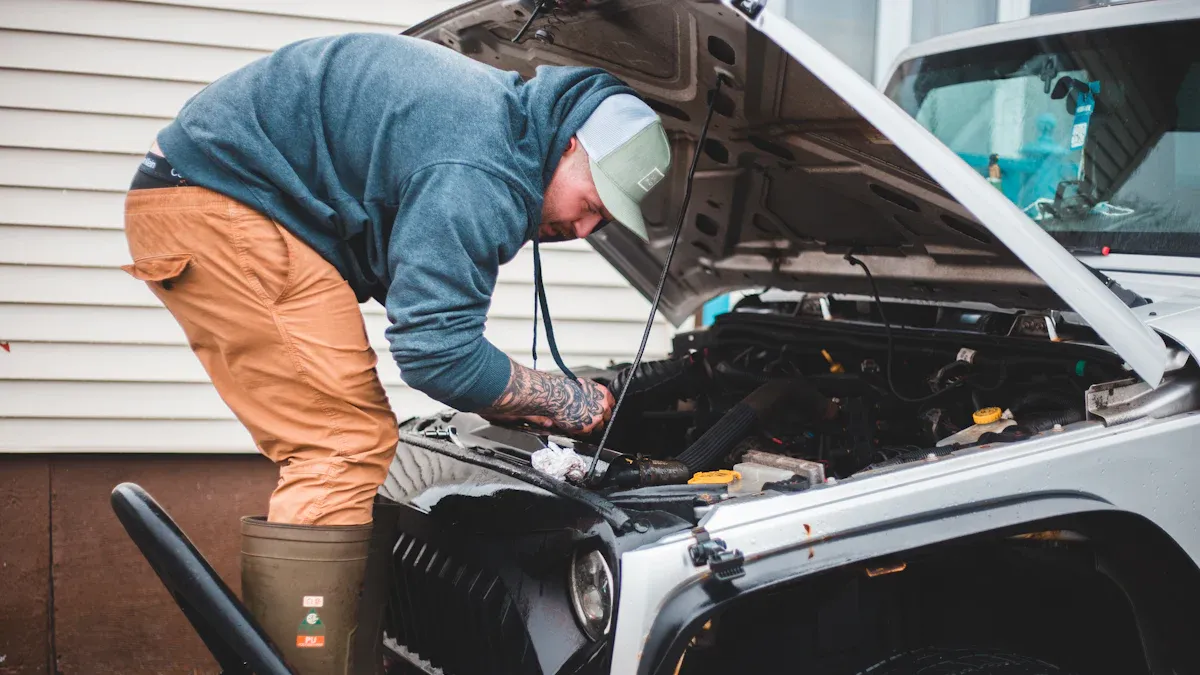A faulty harmonic balancer can disrupt engine performance and cause severe damage. It absorbs vibrations from the crankshaft, ensuring smooth operation. Issues with a Gm Harmonic Balancer or an External Balance Harmonic Balancer may lead to misaligned components. Timely crankshaft harmonic balancer replacement prevents costly repairs and protects the engine’s integrity.
Key Symptoms of a Bad Harmonic Balancer

Excessive Engine Vibrations
Excessive vibrations from the engine often indicate a failing harmonic balancer. This component absorbs vibrations generated by the crankshaft. When it malfunctions, the engine shakes more than usual, especially at higher speeds. These vibrations can become dangerous if left unchecked. Drivers may also notice reduced engine performance, which further signals potential issues with the harmonic balancer.
- Common signs include:
- Noticeable shaking during operation.
- Increased vibrations at high speeds.
- A wobbling crankshaft pulley.
Knocking, Rattling, or Squeaking Noises
Unusual noises, such as knocking, rattling, or squeaking, often accompany a defective harmonic balancer. These sounds typically vary with engine speed and may be mistaken for internal engine problems. The noises result from the balancer’s inability to function properly, causing misalignment or damage to connected components.
- Key indicators include:
- Rattling or knocking sounds from the engine.
- Squeaking noises that increase with engine speed.
Visible Wobble or Damage to the Harmonic Balancer
A visual inspection can reveal clear signs of a bad harmonic balancer. Cracks, wear, or deterioration of the rubber insulator are common. Over time, the rubber may separate from the metal parts, leading to a wobble when the engine runs. Regular maintenance checks can help identify these issues early.
- Look for:
- Cracks or physical damage on the balancer.
- Deterioration of the rubber insulator.
- Separation between the hub and outer ring.
Misaligned or Slipping Drive Belts
A faulty harmonic balancer can cause the drive belt to slip or misalign. This abnormal movement may produce clicking or squealing noises while the engine operates. Misaligned belts can also lead to further damage to the pulley system.
- Symptoms include:
- Drive belt slipping off its track.
- Clicking or squealing noises during operation.
Check Engine Light Activation
A failing harmonic balancer can trigger the check engine light. This occurs when the crankshaft position sensor detects irregular signals caused by the balancer’s malfunction. Drivers should not ignore this warning, as it may indicate severe engine issues.
Timing Issues or Slipping Timing Marks
Timing problems often arise when the harmonic balancer fails. The outer ring may slip, causing the timing marks to misalign. This can lead to improper engine timing, affecting overall performance.
| Evidence Type | Description |
|---|---|
| Key Failure | Harmonic Balancer Failure |
| Symptoms | Improperly timed engines due to slipped outer ring keyways; check timing marks position. |
Risks of Ignoring a Faulty Harmonic Balancer
Ignoring a faulty harmonic balancer can lead to severe engine damage and costly repairs. This component plays a critical role in maintaining engine stability. When it fails, the consequences can escalate quickly, affecting multiple systems in the vehicle.
Crankshaft Damage
The harmonic balancer dampens torsional vibrations in the crankshaft. Without it, these vibrations can cause the crankshaft to weaken or even break. Over time, excessive heat and force can deteriorate the balancer’s rubber components, further increasing the risk of damage.
| Mechanism of Harmonic Balancer | Consequence of Failure |
|---|---|
| Dampen torsional distortion | Can lead to crankshaft breakage |
| Absorb vibrations | Vibrations may cause engine failure |
Belt and Pulley System Failure
A malfunctioning harmonic balancer often affects the belt and pulley system. Drivers may notice unusual noises, such as knocking or rattling, or visible wobbling during engine operation. These issues can lead to belt misalignment, slipping, or even complete failure of the pulley system.
- Common signs include:
- Wobbling harmonic balancer.
- Squealing or clicking noises.
- Visible wear on belts and pulleys.
Increased Engine Wear and Tear
Neglecting harmonic balancer maintenance increases strain on engine components. This strain can lead to premature wear of bearings, pistons, and connecting rods. Over time, the engine’s efficiency decreases, and the likelihood of mechanical failure rises.
- Key risks:
- Worn rod bearings.
- Increased stress on pistons and connecting rods.
- Reduced engine longevity.
Potential for Complete Engine Failure
In extreme cases, a failing harmonic balancer can result in total engine failure. Heat stress and rubber deterioration may cause the balancer to disintegrate, damaging internal components like the crankshaft and pistons. This level of damage often requires an engine rebuild or replacement, which is both time-consuming and expensive.
Post time: Mar-17-2025



